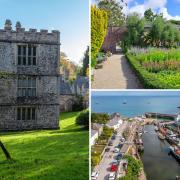LOCATION

This section of the Cornwall Area of Outstanding Natural Beauty (AONB) includes the most westerly stretch of the Cornwall peninsula, extending from the western edge of St Ives around Cape Cornwall and inland to include the central Penwith Hills (also referred to as the Downs’ or Moors’). From Sennen Cove and Land’s End the AONB narrows and the A30 forms the inland boundary. Eastwards the AONB remains mostly south of the B3315 extending to Penlee Point just east of the coastal village of Mousehole.
West Penwith forms 15% of the overall designated area of the Cornwall AONB covering approximately 14,000 hectares or just less than 139 square kilometres.
GETTING OUT AND ABOUT
The South West Coast Path website provides a series of walking routes around the peninsular for all abilities () as does i-walk Cornwall which offers an interactive map with a series of circular walks taking in the various sections of West Penwith ().

The National Trust is responsible for managing Cape Cornwall where there is ample parking for members and visitors together with a small refreshment kiosk and toilet facilities. There are also a range of walks available on their website ().
BUSES
An open top bus ride is an excellent way for all the family to experience the delights of the West Penwith landscape () Summer Service 300 is a circular tour which starts in Penzance.
INFO
The Visit Cornwall website provides lots of information on what to do and where to stay in the area ().
Also check out the Cornwall Council public transport link for information on buses in the area ().
If you would like to find out more about the Cornwall Area of Outstanding Natural Beauty head to cornwallaonb.org.uk where you will find further information about what we do. If you are interested in becoming a volunteer in various parts of the 12 designated Cornwall AONB areas drop the AONB team an email at info@cornwall-aonb.gov.uk
Almost a third of Cornwall sits in an Area of Outstanding Natural Beauty. Join us as we continue to explore its sections. This month we head to West Penwith.
There are a number of factors that have influenced the character of the landscape on West Penwith. There is the underlying geology of granite, the impact of extreme exposure to the prevailing winds and weather from the Atlantic Ocean and the influence of human habitation from the Neolithic period (4000 – 2500BC).
The hard granite coastline of this most south-westerly section of the Cornwall AONB has been sculpted by wind and weather into a sequence of headlands punctuated by substantial chasms known locally as zawns’. The granite rises to its highest point in a series of gently rounded hills, stretching in an arc from Trencrom Hill in the east to the highest point of Watch Croft with the small rounded hill of Chapel Carn Brea in the east. On the southern and eastern sides of the hills, the slopes tend to be gentler and fall gradually towards Mount’s Bay and the coast to the west of Penzance and Newlyn.
Legend has it that Trencom Hill was the home of the giants said to have ruled Cornwall and who regularly fought with those of Carn Brae to the east and The Mount to the south.
The south western peninsula of the Cornwall AONB is characterised by the relics of the mining industry stretching from the Cot Valley at St Just northward to Pendeen. The area was extensively mined for centuries and in its day would have echoed to the sounds of beam engines pounding away as the miners worked deep underground in an oppressive, hot and dangerous atmosphere. There were no cages to haul miners up and down the mineshaft in those early days, instead mines were reached by ladders stretching down some 100 feet. Miners were also responsible for buying their own tools, candles and dynamite out of their already meagre wage. In the 18th and 19th century, it was not uncommon for children to be employed in the tin mines. In 1839, some 7,000 children were employed in the Cornish tin mines as well as women who were known as Bal Maidens’ and who were employed to break up the rock as it was brought to the surface (see ).
There are so many places of interest to visit on West Penwith and one really does get a feeling of the historic nature of this landscape. The South West Coast Path is an ideal way to take in all that the peninsular has to offer () - be it the picturesque fishing village of Mousehole or the aptly named Cape Cornwall where the Atlantic Ocean meets the English Channel. The name Cape Cornwall first appeared on maritime charts around the year 1600 when it was known as its original Cornish name of Kilgodh Ust meaning gooseback of St Just’ which is a reference to the shape of the cape and which is now managed by the National Trust ().
No visit to West Penwith would be complete without stopping off at the world famous Minack Theatre standing high above Porthcurno Bay. The theatre appears to be an ancient monument dating back some 2000 years with its classic Greek architecture but is in fact the vision of a remarkable woman called Rowena Cade (1893-1983) who built this amazing landmark initially with only the help of her gardener, commencing the work in the winter of 1931 with continued alterations and development throughout her life.
Whatever you do make sure you allow yourself plenty of time to explore this section of the Cornwall AONB and experience first-hand some of its hidden treasures ().
WILDLIFE – what to look out for
On the land
West Penwith is an ancient landscape with some spectacular scenery which distinguishes it from the rest of England and even from the rest of Cornwall, its mild and wet climate as the most south-westerly peninsula of the British Isles is exposed to the full force of Atlantic gales.
The Cornish hedges and derelict mine works provide important wildlife habitats and the mild climate encourages several plants and animals which are near the northern limit of their range in Europe.
The heathland and Cornish hedges offer sanctuary for common reptiles such as the adder and common lizard, while the ponds support strong populations of common frogs and toads and the disused mineshafts offer shelter for a variety of species of bats.
Cornish hedges have an essential role in the countryside acting as wildlife corridors’ not dissimilar to linear strips of woodland edge or other semi-natural habitat in a sea of agricultural land, providing shelter for a diversity of invertebrates, small mammals and birds.
In the water
The peaceful rivers and streams found in west Penwith provide the perfect habitat to support otters, eels and brown/sea trout.
The waters around West Penwith provide perfect conditions for a variety of marine wildlife, dolphins, Minke whales and Basking sharks along with the rarer Risso’s dolphin can all be spotted. Cornwall Wildlife Trust runs an extensive marine conservation programme known as Living Seas () helping to raise awareness and understanding of protecting marine life.
In the air
Rare birds such as Skylarks, Song thrush and Linnets also thrive in the peace and tranquillity of the peninsula whilst the coastal cliffs and adjacent farmland provide perfect habitat for populations of stonechats, peregrines and ravens. West Penwith is also an important stopping-off’ point for several migratory birds in the spring and autumn.
Nature reserves
Cornwall Wildlife Trust has several nature reserves in this section of the Cornwall AONB () and areas of land at Lower Bostrase and Leswidden are designated Special Areas of Conservation and Sites of Special Scientific Interest.


























